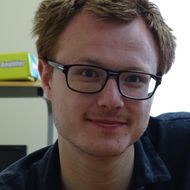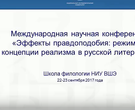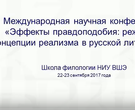- A
- A
- A
- АБB
- АБB
- АБB
- А
- А
- А
- А
- А
- Национальный исследовательский университет «Высшая школа экономики»
- Факультет гуманитарных наук
- Школа филологических наук
- Лекции Дагмар Дивьяк (университет Шеффилда)
-
Школа
- О школе
- Сотрудники
- Образовательная деятельность
- Научные семинары школы
- Аспирантская школа по филологическим наукам
- Майнор "Инструменты эффективной коммуникации"
-
Проекты школы
-
- Летопись жизни и творчества Б.Л. Пастернака
- Большой проект «Русская литература в социальном измерении: компьютерная платформа СОЦИОЛИТ»
- Всеволод Некрасов. Литературный архив
- Большой проект «Речевые практики»
- Трансформация коммуникативной модели в эго-текстах русского модернизма
- Сравнительное изучение метрического стихосложения на фоне языковой просодии: цифровая аналитическая платформа “Прозиметрон”
-
- Майнор "История литературы"
-
Подразделения
- Лаборатории
- Научно-учебные группы
- Мандельштамовский центр
Адрес: 105066, г. Москва,
Старая Басманная ул., д. 21/4
Шаги/Steps. 2024. Т. 10. № 1. С. 12-67.
Лифшиц А. Л., Святохина Е. В.
В кн.: Вспомогательные исторические дисциплины в современном научном знании: Материалы XXXVI Всероссийской научной конференции с международным участием. Москва, 4–5 апреля 2024 г.. М.: ИВИ РАН, 2024. С. 220-221.
Лекции Дагмар Дивьяк (университет Шеффилда)
Приглашаем всех на лекции Дагмар Дивьяк (университет Шеффилда), которые состоятся 8, 14 и 15 апреля на факультете филологии НИУ ВШЭ (Трифоновская ул., 57, аудитория 402 - ст. м. Рижская). Лекции будут читаться на английском языке. Для участия необходимо зарегистрироваться здесь
The quantitative turn in Cognitive Linguistics
Dagmar Divjak The University of Sheffield, UK
8 апреля 16.40, ауд. 402
1. Why cognitive linguists have come to like data.
In this first talk I look at the quantitative turn in Cognitive Linguistics. According to a recent survey (Janda 2013), the majority of conference presentations, articles, and books in our field now relies on some kind of quantitative information language data, and analyzes the data using statistical methods. I will zoom in on one type of quantitative data, i.e. information on frequency of occurrence, and explain why cognitive linguists' fascination with frequency is unavoidable and why working with frequencies of occurrences necessitates the use of statistics.
8 апреля 18.10, ауд. 402
2. Modelling the aspect-modality interaction in Russian, Polish and Serbian: pieces of a cognitive puzzle.
In the second talk I present a case-study that looks into the assignment of aspect in Russian, Polish and Serbian modal constructions. Unlike previous accounts, I take a strictly corpus-based, quantitative approach within which corpus data on the relationship between aspect and modality are modeled using mixed effects binary logistic regression. The model suggests that (contrary to assumptions in the Western literature, but in line with claims from Russian linguists) aspect choice is not best predicted by modality type, and that the relation between modality type and aspect needs reversing: imperfective infinitives prefer to convey deontic meanings while perfective infinitives prefer expressing dynamic modality. I will argue that, from a cognitive linguistic point of view, the use of aspect in modal contexts is a case of analogical mapping between domains.
14 апреля 18.10, ауд. 402
3. Machine meets man: can a statistical model predict what a speaker will like best?
In the third talk, I focus on the question of what language has to offer speakers/learners in their quest for the meaning of lexemes and the concepts they give access to. I will present results of an ongoing research project that tracks the behaviour of 6 near-synonyms that express the concept TRY in Russian in a representative sample of language. The statistical model, designed to predict the preference for one of the 6 near-synonyms, is cross-validated by letting it compete against human beings in a series of psycholinguistic experiments. The results show that machine and human beings perform at the same level and show similar error patterns. The findings thus provide support for the Distributional Hypothesis (Harris 1954) that says that the meaning of a word is derived from the linguistic contexts in which it occurs and are relevant for concept acquisition and representation in general.
15 апреля 16.40, ауд. 402
4. Which frequencies (should we) count?
Linguists are increasingly relying on corpus data when describing linguistic phenomena and formulating hypotheses that need to be validated experimentally. Sometimes textual and behavioural evidence converges; oftentimes it diverges. Evidence has thus begun to accumulate suggesting that “frequent in the text” does not always and straightforwardly mean “important in the head”, and this poses a problem for usage-based theorizing on language. In my talk, I discuss a range of studies and present data from a large scale study on Polish that-constructions showing that diverging evidence is partly due to methodological deficits. One size does not fit all: different types of textual data need to be counted in different ways, depending on the phenomenon studied, the research question asked, and the cognitive ability that is being tapped in to.
15 апреля 18.10, ауд. 402
5. Frequency in language: context, memory and attention.
I will round up this series of talks by considering some of the currently available ways in which we can capture frequency information and argue that we need to relate the measures we already have available and those that we are developing to what we know about human memory systems. This is a necessary first step towards answering the fundamental question of what can be counted in texts and how it needs to be counted to best approximate cognitive representation. Such knowledge will make it possible to develop cognitively realistic ways of tracking occurrence frequencies and deepen our understanding of the role frequency plays in language acquisition, processing and representation.
Лекции будут прочитаны в здании факультета филологии по адресу: Трифоновская ул., д. 57, строение 1, ауд. 402
Как пройти на факультет филологии НИУ ВШЭ: от м. Рижская пройти по подземному переходу под Рижской эстакадой к гостинице Холидей-Инн (спуститься в переход, ведущий к Рижскому вокзалу, идти по указателям "Трифоновская улица"). Выйдя из перехода, идти вдоль зеленого решетчатого забора (слева), свернуть в первый проход во дворы, через 100 метров справа будет современное пятиэтажное офисное здание с вывеской ГАСИС, въезд во двор перегораживает шлагбаум. Альтернативный маршрут по ул. Гиляровского и Трифоновской. Карта
- О ВЫШКЕ
- Цифры и факты
- Руководство и структура
- Преподаватели и сотрудники
- Корпуса и общежития
- Закупки
- Обращения граждан в НИУ ВШЭ
- Фонд целевого капитала
- Противодействие коррупции
- Сведения о доходах, расходах, об имуществе и обязательствах имущественного характера
- Сведения об образовательной организации
- Людям с ограниченными возможностями здоровья
- Единая платежная страница
- Работа в Вышке
- ОБРАЗОВАНИЕ
- Лицей
- Довузовская подготовка
- Олимпиады
- Прием в бакалавриат
- Вышка+
- Прием в магистратуру
- Аспирантура
- Дополнительное образование
- Центр развития карьеры
- Бизнес-инкубатор ВШЭ
-
http://www.minobrnauki.gov.ru/
Министерство науки и высшего образования РФ
-
https://edu.gov.ru/
Министерство просвещения РФ
-
http://www.edu.ru
Федеральный портал «Российское образование»
-
https://elearning.hse.ru/mooc
Массовые открытые онлайн-курсы
- © НИУ ВШЭ 1993–2024 Адреса и контакты Условия использования материалов Политика конфиденциальности Карта сайта
- Редактору






